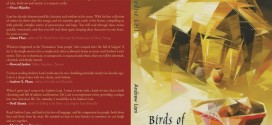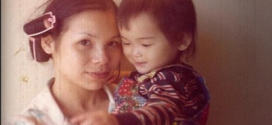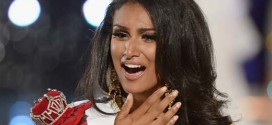Thuy Linh Nguyen Tu is Assistant Professor of Asian Pacific American Studies at New York University. In her most recent book, The Beautiful Generation, Tu explores the rise of Asian Americans in high fashion and what ramifications it has for the fashion industry as a whole. She draws on conversations with design students, fashion curators, and fashion publicists; interviews with nearly thirty Asian American designers who have their own labels; and time spent with those designers in their shops and studios, on their factory visits, and at their fashion shows. The Beautiful Generation links the rise of Asian American designers to historical patterns of immigration, racial formation, and globalized labor, and to familial and family-like connections between designers and garment workers.
Since the 1990s, young Asian Americans including Doo-Ri Chung, Derek Lam, Thakoon Panichgul, Alexander Wang, and Jason Wu have emerged as leading fashion designers. They have won prestigious awards, been chosen to head major clothing labels, and had their designs featured in Vogue, Harper’s Bazaar, and other fashion magazines. At the same time that these designers were rising to prominence, the fashion world was embracing Asian chic. During the 1990s, “Asian” shapes, fabrics, iconography, and colors filled couture runways and mass-market clothing racks. Here is an excerpt from the book:

FASHION, FREE TRADE, AND THE ‘‘RISE OF THE ASIAN DESIGNER”
On December 11, 1990, U.S. officials charged into a nineteenth- century, brick, walk-up apartment building at 247 Mulberry Street in New York City and arrested John Gotti Sr., the suspected leader of the Gambino crime family. Home of the Ravenite Social Club where Gotti and his associates ran their organized crime business, the building stood in the heart of a small residential neighborhood stretching no further than the few blocks running along Elizabeth, Mott, and Mulberry Streets, on the northern edge of New York’s Little Italy. After Gotti’s arrest, the Ravenite building was sold to the investment group Allied Partners, which immediately knocked down the walls of its cramped rooms and replaced its bricked-up windows with a glass storefront. Before long, they had transformed the notorious social club into a bright new retail space. On February 23, 1999, the date of the auspicious lunar new year’s eve, the handbag designer Amy Chan opened her first store in the old Ravenite building. After she hung her logo—a lucky number eight—over the door and made her feng shui adjustments, the only hint of the social club left was the cracked black- and-white tiled floor, where New York’s iconic Italian gangsters made their last stand.
Chan’s appearance at 247 Mulberry was a sign of changes to come, not just for the Ravenite building but for the whole neighborhood. Shortly after her arrival, a host of other designers began replacing its old tenements and boarded up storefronts with shiny new boutiques. Over the course of just a few years, they transformed it into the shopping mecca now known as Nolita.

Among those who joined Chan were Anna Kim, Margie Tsai, Elaine Kim, Kazuo Nakano, and Jennifer Wang—second-generation Asian American women who, like so many of Nolita’s pioneers, were eager to try their luck in one of the city’s oldest industries: the clothing business. The prevalence of these women in Nolita and nearby in the also rapidly changing East Village was such that in 2000 The New York Times dubbed the area from the Lower East Side to Tribeca a ‘‘Little Seoul in the making’’ in honor of the ‘‘hip little fashion shops owned and supplied by young Korean-Americans, the daughters of immigrants who have moved on from the greengroceries and dry cleaners of their parents’ generation and entered the fashion world.’
These shops provided a kind of visual proof that the same newspaper’s speculation just five years before was right—we were seeing what the Times dubbed the ‘‘Rise of the Asian designer.’’ Citing the prominence of figures like Anna Sui, Vera Wang, and Vivienne Tam, and the burgeoning number of Asian students at institutions like the Parsons School of Design, the Times had announced in 1995 that ‘‘Asians, whose nimble hands have for decades sewn in factories in the United States and Asia,’’ had now also ‘‘become an emerging force in design.’’ The paper did not make clear whether these conditions were causally linked or merely coincidental, but its emphasis on a narrative of transformation hinted that something historic was in the making.

The Times was right in this instance. At the beginning of the twenty-first century, Asian Americans, whose presence in the fashion industry had previously been virtually nonexistent, seemed to be thriving in that field. Their clothes were being regularly featured in the pages of Vogue, Harper’s Bazaar, Elle, W, InStyle, and other door-opening fashion publications. They were winning an unusually high percentage of the prestigious fashion awards, particularly the recently established prizes for new designers. As of 2007, Asian American designers had won eleven of the forty-one Ecco Domani Fashion Foundation awards; they were ten of the forty finalists for the coveted cfda/Vogue Fashion Fund prize. They even nabbed a few of the most coveted honors, including the Swarovski Award for Womenswear, awarded by the cfda (the Council of Fashion Designers of America), which went to Philip Lim in 2007, Doo-Ri Chung in 2006, and Derek Lam in 2005 (between 2003 and 2006, this award was known as Swarovski’s Perry Ellis Award for Womenswear). In 2009, Jason Wu won what amounted to a prize when Michelle Obama, after much suspense and speculation, chose to wear his dress to the inaugural balls. And, in perhaps the clearest indication of their status, Asian Americans were tapped to head up major design labels (Peter Som for Bill Blass) and to design capsule collections for mass- market firms (Richard Chai and Thakoon Panichgul for Target).
At approximately the same time that Asian American designers were emerging as a force on Seventh Avenue, fashion enthusiasts were becoming enthralled with another trend. During the 1990s, Asian chic—or ‘‘the utopian and euphoric embrace of elements of particular Asian traditions that have now come to stand in for an undifferentiated Asia,’’ as the anthropologists Carla Jones and Ann Leshkowich have characterized it—captured the sartorial imagination. So-called Asian shapes, fabrics, iconography, and colors pervaded the sartorially high and low, appearing on both the couture runways of Yves Saint Laurent and Gucci and the mass-market racks of Urban Outfitters and Target. Celebrities and socialites donned kimonos, cheongsams, and salwaar-kameez for the red carpet. Magazines and newspapers filled their pages with countless ‘‘East meets West’’ photo shoots, fashion layouts, and advertising campaigns. In that decade, Asian chic dominated the fashion landscape.
MATERIAL MAO
fashioning histories out of icons
In 1997, as an inexperienced and struggling designer, Han Feng showed a collection that would wow critics and launch her into the fashion spotlight. Feng, who had been working in fashion since 1985 (first as a clerk at Bloomingdale’s) had started producing her own clothes just three years earlier, when the pleated silk scarves she made in her apartment sold out unexpectedly. But she managed to dazzle audiences with a collection that seemed to perfectly express the mood of the moment. Composed of loose, brightly colored pants and matching tops, sewn in silk, velvet, and other luxurious fabrics, it invoked the Chinese-born designer’s cultural roots in an appropriately modern manner. Tunics were updated in sleek cuts; dresses were sewn in fabrics both opulent and wearable. To pull together the look, Feng sent her models down the runway made up as colorful coolies, complete with coolie hats and queues. Waiters at the event served tea, and the clothes were an- nounced with the strike of a gong.∞
Feng’s liberal incorporation of so-called Eastern colors, elements, and motifs into her work (and its presentation) won her many fans during her now decade-long career. The marriage of East and West—as she has often called her style—evident in her first collection garnered her much acclaim in the fashion world and beyond. Feng became recognized as an expert on Asian culture and was able to parlay this expertise into opportunities in other cultural realms. In 1998, she was commissioned by the John F. Kennedy Center for the Performing Arts, in Washington, D.C., to create costumes for the East-meets-West themed production of David Maddox’s ‘‘Gandhara: East West Passages.’’ Feng was later tapped to design the cos- tumes for Anthony Minghella’s Madama Butterfly, a co-production of the English National Opera and New York’s Metropolitan Opera in 2006. It was clearly Feng’s touch with exotic imagery that enabled her expansion into these other performative realms. As Minghella—perhaps best known as the director of such films as The English Patient and Cold Mountain—raved to Women’s Wear Daily: ‘‘Han Feng is a firecracker . . . She has that special gift of taste and flair and fearlessness which mixes together strange foods, strange fabrics, strange colors, and alchemy happens.’’
This flair for the ‘‘strange’’ is a characteristic that Feng has worked hard to cultivate. During the 1990s, she could often be seen on television and in magazines instructing viewers on how to throw Asian-themed parties and where to find the best Asian food. Describing herself on her Web site as ‘‘one of the few figures capable of bridging contemporary Chinese style and culture with a global perspective,’’ Feng was (and still is) more than just a designer.≥ She continues to o√er her expert knowledge to the entertain- ment world, most recently as a costume consultant for The Karate Kid remake starring Jackie Chan and Jaden Smith.
During the heyday of Asian chic, designers like Feng could—by virtue of their ethnic identities, both claimed and imposed—assume the mantle of guide and guru, able to unlock Asia’s many secrets in fashion and beyond. Many took up these roles with zeal. These designers spurred on the ap- petite for Asianness by o√ering the industry an Asia filled with romance and nostalgia, glamour and spectacle, and by embracing its strategies of representation and its logic of distance. There is ample evidence to suggest that Asian Americans can at times be as Orientalist as any other designer. Yet if we stop our analysis there—at critiquing their complicity in these regimes of representation—we would discover very little about what else these exotic creations might have enabled their designers to say.
This is an excerpt from The Beautiful Generation by Thuy Linh Nguyen Tu, available on Amazon and at https://www.dukeupress.edu/the-beautiful-generation
 Asian Fortune Your source for all things Asian American
Asian Fortune Your source for all things Asian American



